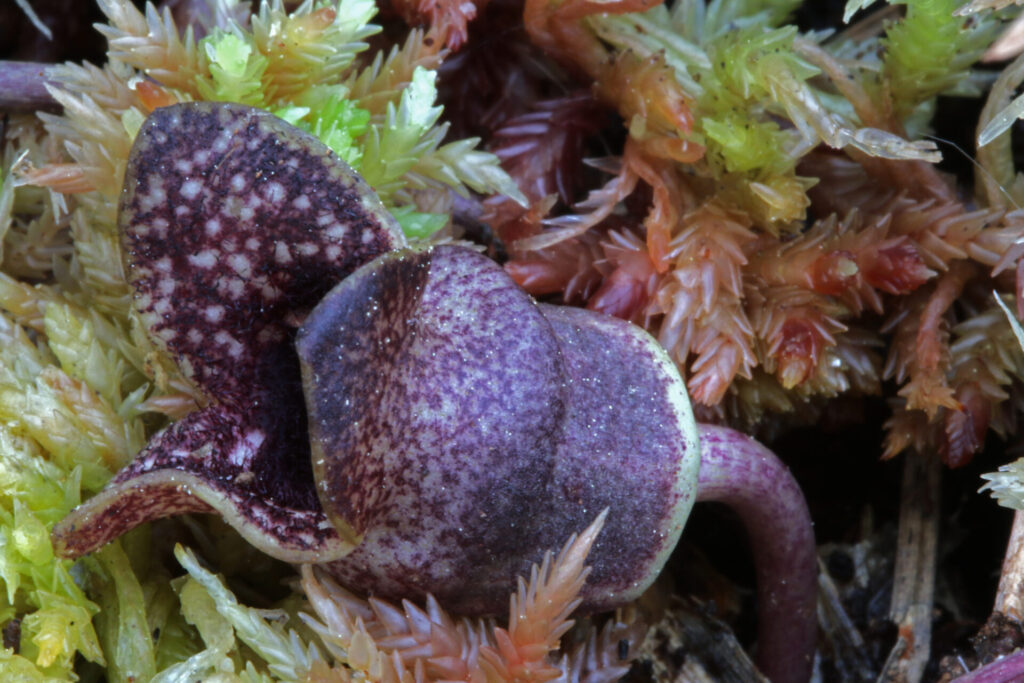By Jean Woods
It was a foggy, wet, early morning in 2006 as I gathered with several others to begin our covert mission to save lives. We were dressed in boots and rain gear, carrying tools to accomplish our mission. We met at an older house at the end of a dirt road next to a densely wooded area in rural Gaston County. We were one half of the mission team. The other half would remove the endangered lives and transport them to us. We, in turn, would carry them carefully through the woods, down a slope and up again to the safe abode where we would establish them in a new home to provide them the basics of life.
What lives were we saving? The lives of some very special plants: Hexastylis naniflora or Dwarf-flower Heartleaf.
There are 190 populations of H. naniflora in North Carolina and the northwestern piedmont of South Carolina, (https://connect.ncdot.gov/projects/research/RNAProjDocs/2012-17%20Final%20Report.pdf ). One of these populations existed on a property owned by the Gaston County airport, which was to be used for an extension of the existing runway. These plants were discovered when the ecological impact study was done for the runway extension. Environmental consultants had been hired to move the plants to another location. There was a problem, however.
The problem was finding a place where Dwarf-flower Heartleaf would grow successfully. Not easy, as this is an endangered species that grows in acidic sandy loam soils along bluffs and ravines and in boggy areas adjacent to creeks and streams (U.S. Fish and Wildlife Service, USFWS). Also, the area had to be safe and hard to access in order to protect them from destruction. Fortunately, the Catawba Land Conservancy had such a property, and that’s where we would transplant the gingers.
For two days, environmental consultants dug, bagged, and transported them to us so we could plant them on the protected property. Facts have been altered a bit as the location must remain secret to protect these unique refugees. From what I hear, most of the plants are happy in their new home. Surveys are done periodically to assess their viability.
Gingers in the Hexastylis and Asarum genera
Twelve named (and two unnamed) species of the Hexastylis genus are found in North Carolina, along with three cousins in the Asarum genus. Some are more common, and some are hard to find unless you have some plant geek help you. All of these are called gingers because the early Europeans found the spicy smell “ginger like” and used the roots to add flavor to foods. However, most references say that all parts of the plant are toxic and not to be eaten. Make sure children realize this when you introduce this plant to them.
Gingers are low growing and are pollinated by crawling insects like beetles and ants. These same insects will also disperse the seeds (Spira, Timothy. Wildflowers & Plant Communities of the Southern Appalachian Mountains & Piedmont. Chapel Hill, University of North Carolina Press, 2011). While the deciduous Common Wild Ginger (Asarum canadense) spreads moderately quickly, the evergreen Hexastylis gingers spread very slowly and are not quick ground covers, but they do make attractive and interesting single plants or as a small patch of green.
Gingers are collected and hybridized for their interesting leaf mottling. Many gingers, along with European and Asian species, can be found in the nursery trade and are suitable for shade gardens in rich, moist soils.
Descriptions of each species growing in North Carolina are included below. Also, here is a PDF link to a table of all the gingers with their characteristics, Table of Hexastylis and Asarum in North Carolina. This is a quick reference to take with you on hikes.
Asarum
Asarum canadense, or Common Wild Ginger, is a ginger in a different genus within the Aristolochiaceae family, that looks like its Hexastylis cousins and has a similar flower.
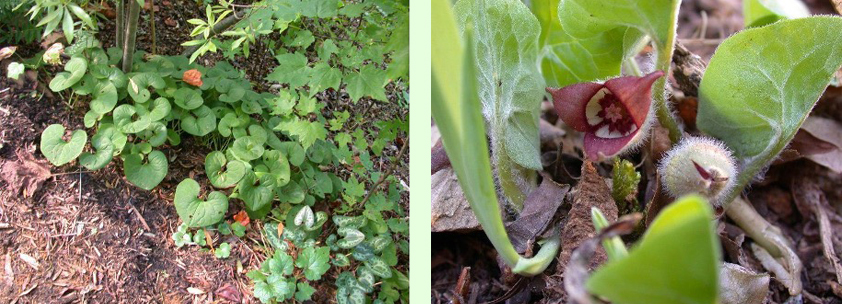
Common Wild Ginger is a low-growing, colony-forming perennial that dies back in the winter. Otherwise it is a great shade ground cover. It is easy to obtain in the nursery trade and grows well in the North Carolina mountains and piedmont primarily, and in two counties on the coast. I have a large patch in my yard and it is quite happy in Brevard. I also grew it in Charlotte. Asarum canadense grows in deciduous forests in more circumneutral soils. The “flower” or calyx as it is properly called, is maroon with pointed, reflexed lobes or lips. The sepals that form the calyx are not fully fused, so you can see lines on the side of the calyx. Common Wild Ginger forms colonies and you will find patches of it.
There are two other species of Asarum in North Carolina. Asarum acuminatum and A. reflexum. Asarum reflexum is common in the piedmont but rare in the mountains, while A. acuminatum is found in the foothills and a few places in the mountains, but it is rare in the piedmont. The three Asarums are shown with their characteristics on the Table of Hexastylis and Asarum in North Carolina (link above.) Like A. canadense, these gingers have deciduous leaves and form clumps.
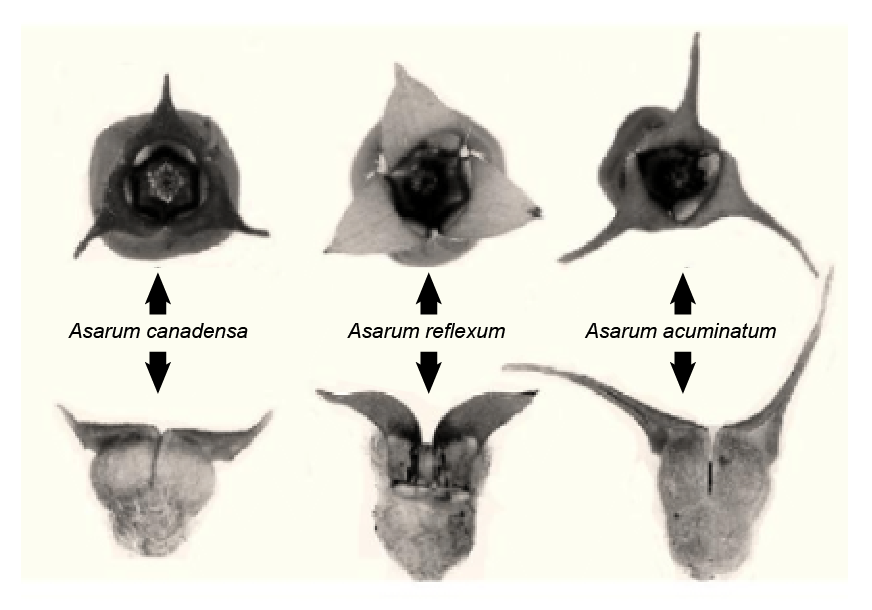
https://www.researchgate.net/project/Flora-of-Alabama
Hexastylis genus
The Hexastylis genus occurs across the state of North Carolina. They thrive in the shade under trees, in moist (not wet) locations usually in rich forests. There is a discussion of the genus with a key located in the Herbarium at NC State. The “flower” or jug is actually formed by sepals that are fused together. Gingers have no petals. Inside the jug, you can see the stigma and stamens. When you look at this key or other keys for gingers they will talk about the calyx, which is the outer whorl of a flower consisting of separate or fused sepals. In our case, the calyx is the “flower” found under the leaves of gingers. For reference, see Dictionary of Botanical terms. The word “calyx” is used in the rest of this article.
You will also notice that the length of the calyx is given in this key and is used to distinguish the various species. The leaves, mostly, are not significantly different, so identification relies on the size and shape of the calyx. It also means you need to find the plants when the calyx is present, which is late spring and early summer. However, where you find the plant geographically can also be a big hint.
Here is a picture showing relative size.
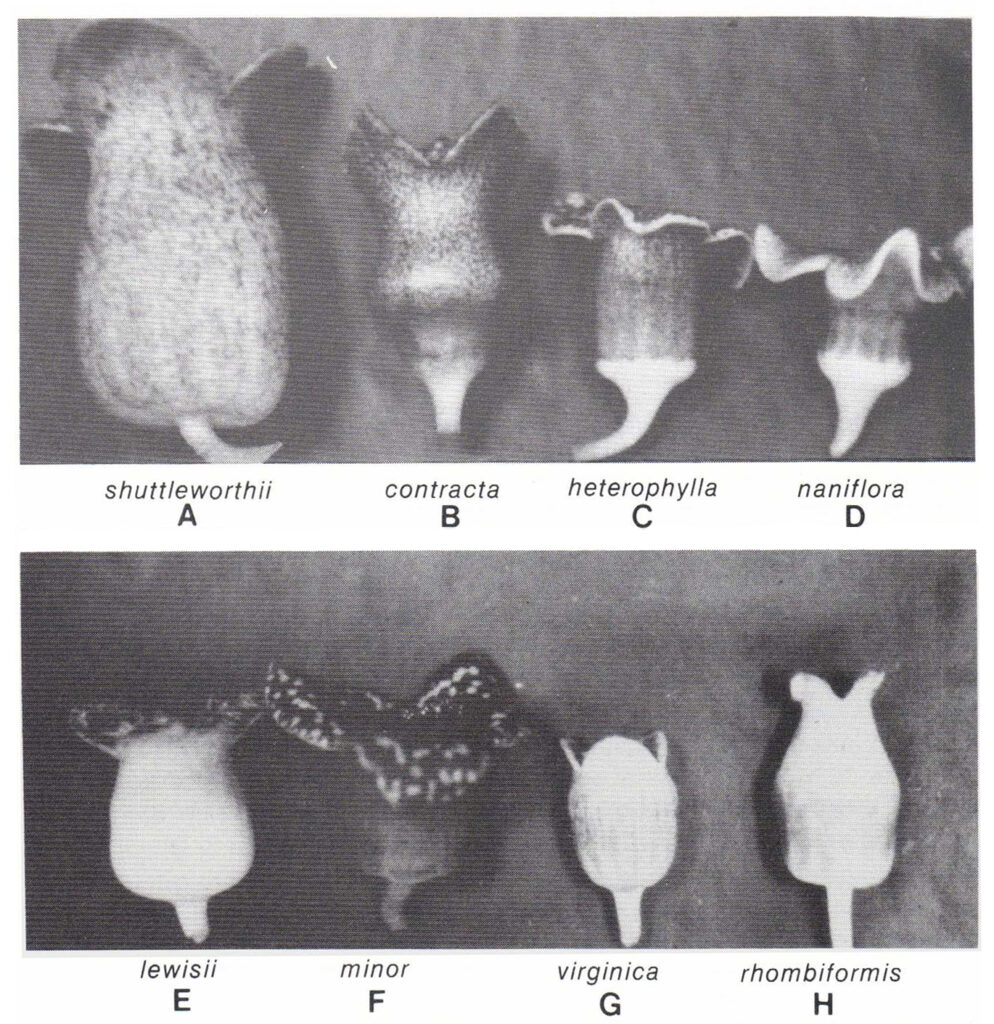
Hexastylis arifolia, Little Brown Jug
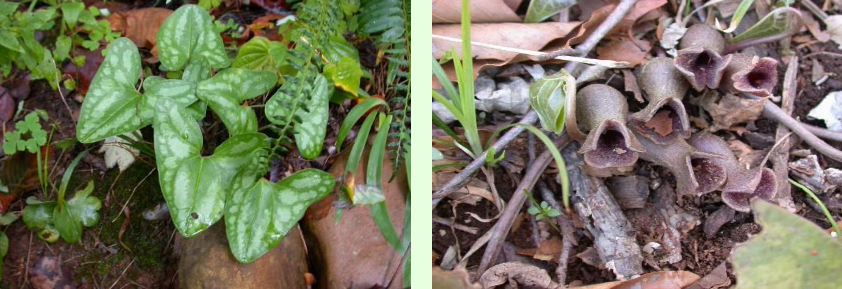
Arrowleaf Heartleaf, Hexastylis arifolia, also known as Little Brown Jug or little pigs, is very common in North Carolina. This ginger is found in the wild from the mountains to the sea. The leaves are triangular in shape, the calyxes are brown, and the calyx lips are not flared. All the other gingers have leaves that are not triangular but instead have cordate or heart-shaped leaves.
- Look for triangle-shaped leaves
- A brown calyx; lips not flared
- Evergreen
Hexastylis minor, Little Heartleaf
Hexastylis minor, or Little Heartleaf, is another ginger you are likely to see, but mostly in the Piedmont. The distribution maps show it as found in Pitt and Martin counties on the coast, but its main range is the middle of the state. Hexastylis minor is smaller and the calyx is the most attractive (in my opinion) of all the gingers.
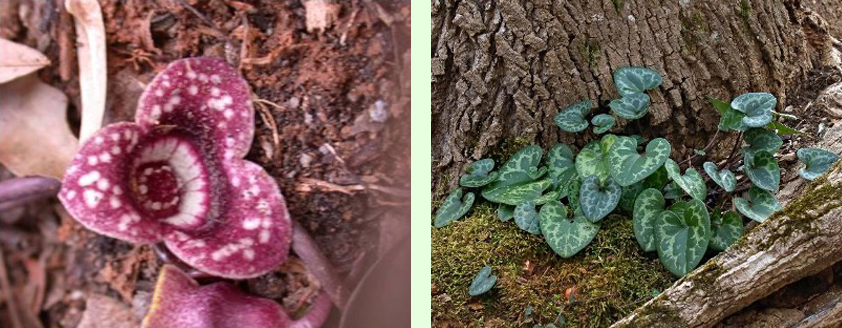
- Found in the Piedmont
- Leaf is heart shaped
- The calyx is a beautiful, variegated maroon color
Hexastylis shuttleworthii, Large-flower Heartleaf
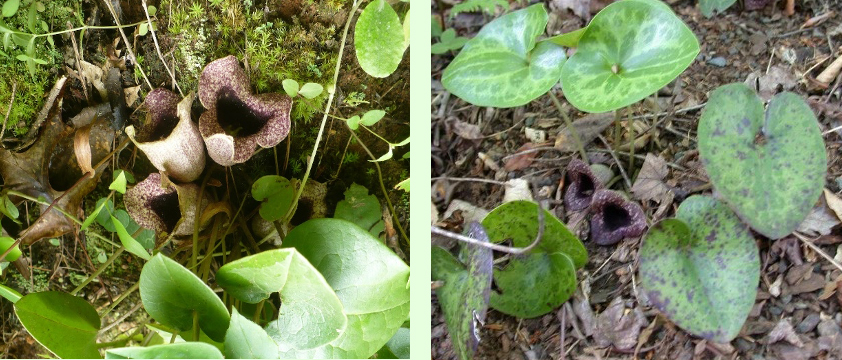
If you are in the mountains and see a ginger with the biggest calyx you ever saw, then it is the Large-flower Heartleaf. The calyx is big, up to about 1.5 inches, brown on the outside and maroon on the inside. Hexastylis shuttleworthii is often found near Great Rhododendron (Rhododendron maximum) on ravine slopes, near creek banks, and often on sloping ground in acidic soil. It can be found along streams and grows on the path along the Davidson River in the Pisgah Forest Campground, Brevard, NC. You will know it by its large calyx.
- Large calyx (10–22mm) Calyx broadest near the middle
Hexastylis lewisii, Lewis’s Heartleaf

If you are in the eastern Piedmont and Coastal Plain of North Carolina and find a ginger in the pocosins, it is probably Hexastylis lewisii. There are populations in 16 counties in North Carolina’s piedmont and coastal plain. It also occurs in Virginia (see NatureServe Explorer). Lewis’s Heartleaf grows in upland forests of pine or oak and in pocosin habitats. The characteristic to look for is whitish hair inside the calyx lobes.
The leaf is about 3 inches long and is more triangular than the other evergreen species, with a rounded tip and somewhat straight side. The leaf base is cordate. The calyx is light brown and urn-shaped to cylindrical with the lobes covered in white hair. (https://auth1.dpr.ncparks.gov/flora/species_account.php?id=199)
- Eastern NC
- Whitish hairs in the calyx
Hexastylis rhombiformis, French Broad Heartleaf
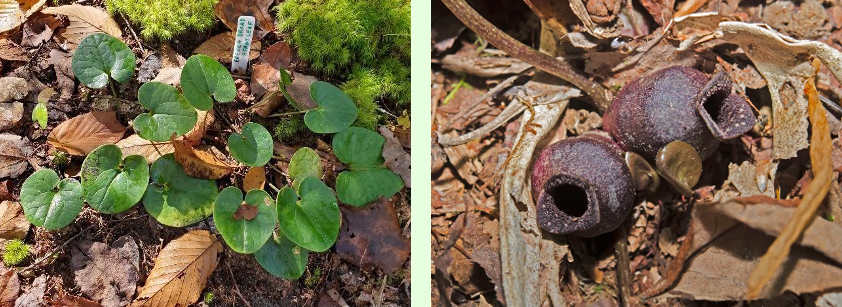
French Broad Heartleaf is endemic to the southern Blue Ridge of NC and SC, known only from Henderson, Polk, Buncombe, and Transylvania counties. It grows in deciduous forests on sandy river bluffs or in ravines with near or under stands of Mountain Laurel (Kalmia latifolia)and/or Rhododendron maximum (Weakly 2015). It has thick, shiny, dark green leaves with or without some pale veining on topof the leaf.
- Location in the above counties
- Calyx tube rhombic-ovate (broadest near the middle); calyx lobes 3–8 mm wideat base (Weakly 2015)
Hexastylis heterophylla, Variable-leaf Heartleaf

Hexastylis heterophylla is found on slopes and bluffs in xeric to mesic forests, usually associated with Kalmia latifolia. It is much more common in the mountains, though there are some sites in the piedmont. It is not easy to identify because of its variability. I once spent almost an hour with others crawling along a bank with a ruler measuring calyxes and taking pictures of leaves and calyxes to positively identify this ginger.
- Calyx tube is cylindrical
- Calyx lobes are moderately spreading to reflexed
- Leaves usually solid green, but can be variegated
Hexastylis virginica
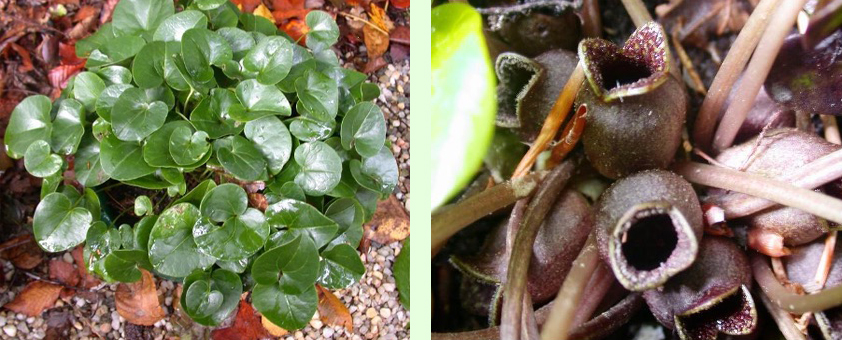
This ginger is most commonly found in Virginia and West Virginia, but ranges down into North Carolina, mostly in the Piedmont but uncommon in the mountains. The calyx is small, about ½ inch, with three short lobes that are erect or slightly ascending, but not widely spreading. See map on the Vascular Plants of North Carolina website.
- Leaves are roundish
- The lips of the calyx do not flare or only slightly
- Entire calyx is convex and small
Hexastylis contracta, Mountain Heartleaf
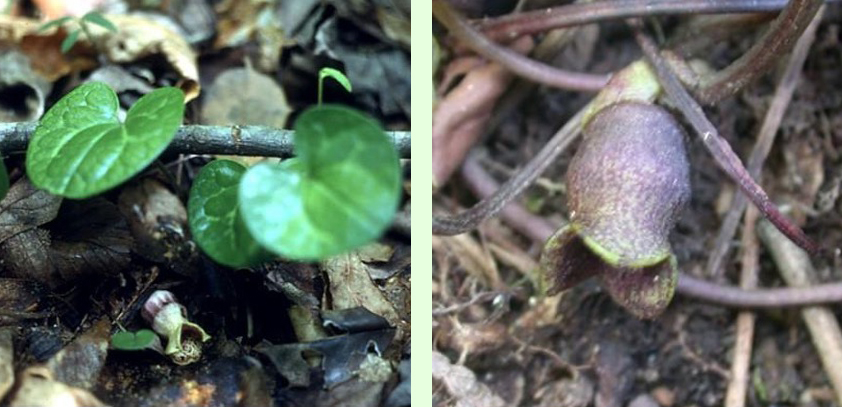
Common to the Tennessee plateau, it has been found in the mountains of NC but is very rare; there are only about 12 populations in North Carolina. This species likes cool, heavily shaded, acidic, hardwood forest often near Kalmia latifolia and Rhododendron maximum. Hexastylis contracta’s flask-shaped calyx, about 1 inch long, has little ridging inside the calyx tube.
Hexastylis roseii, Rose’s Heartleaf
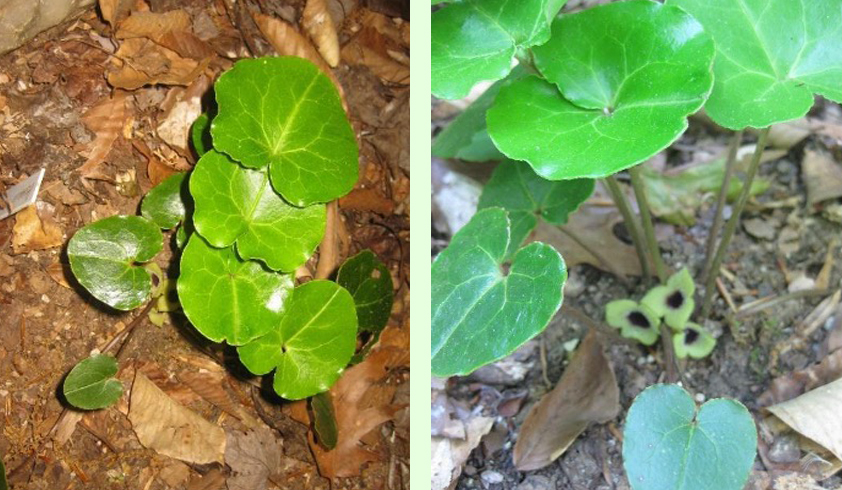
“In 1998, Mark Rose discovered a population of Hexastylis with unusual white sepal lobes, unassignable to any known species (Sinn 2017). The population occurs on a sloped road bank above Wilson Creek in Caldwell Co., North Carolina, near the Blue Ridge Escarpment. (https://www.phytoneuron.net/wp-content/uploads/2021/08/04PhytoN-Hexastylisrosei.pdf). Due to the rarity of this species, its exact location is not disclosed. This ginger can be identified by its ruffled leaves. Mark is a long-time member of the NCNPS and has contributed plants to our sales and auctions for years.
Hexastylis naniflora, Dwarf-flower heartleaf
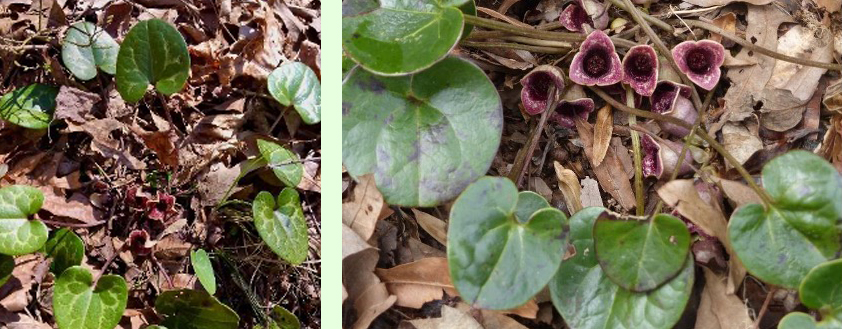
Dwarf-flower heartleaf is federally listed and rare in North Carolina, though new populations have been discovered recently. The calyx is quite small at 4–8 mm. It likes the acidic, sandy loam bluffs and ravines in deciduous forest, often along streams. The lobes are spreading but not erect.
Hexastylis sorriei, Sandhill Heartleaf

Found in the sandhills region of NC (the sandhills region in the southwest corner of North Carolina’s coastal plain includes parts of Cumberland, Harnett, Hoke, Lee, Montgomery, Moore, Richmond, and Scotland Counties). The leaves are solid green or faintly variegated. It is found in the pocosins of the sandhills.
Will Stuart, who took the above pictures, is often in the sandhills photographing plants. Here are his comments about this ginger:
“I see Hexastylis sorriei in the stream heads and pool margins of the North Carolina Sandhills Game Land, sometimes growing among the Cinnamon Ferns and sphagnum and otherwise not far away. The blossoms appear as early as mid-March. There is an area west of Lake Bagget in Richmond County where it is fairly numerous and grows in habitat that leaves little doubt as to species. Most leaves are lightly variegated, but some are not. Weakley mentions the white base of the blossom as a trait of H. sorriei. I photographed that trait in a Bones Fork stream head, also in the NC Sandhills Game Land, a few years ago.“
Hexastylis ruthii, Appalachian Little Brown Jug

Appalachian Little Brown Jug differs from the common Little Brown Jug in that it has a short (2–4mm) calyx. Hexastylis ruthii was lumped with H. arifolia artifolia in the past, but recently upgraded to its own species by Alan Weakley. It grows in “upland acidic forests, ultramafic outcrop barrens, calcareous forests” (Weakley 2022) and is only found in 7 counties in the mountains, where it is uncommon. The mouth of the calyx is more open than in H. arifolia.
Additional Resources for North Carolina’s gingers
This concludes your tour of the gingers of North Carolina. If you are interested in seeing the distribution maps and reading more about each of these, here’s a link to Alan Weakley’s 2022 Flora of the Southeastern States app. Type Hexastylis in the text box in the upper left and press enter. From there you can select the ginger you want to study.
By Jean Woods
Native Plant News – Spring 2023

Jean Woods, of Brevard, is past NCNPS president and former board member of the Catawba Land Conservancy. Currently she serves as chair of the NCNPS Technology Committee. This article was written with help from Bettina Darveaux, Lisa Gould, Tom Harville, Sheilah Lombardo, Penny Longhurst, Mark Rose, and Will Stuart.
